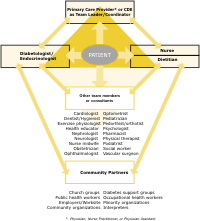 
|
|
![]()

What We Want to Achieve Through Systems ChangesTeam Care: Defining the Team
It is easier to coordinate services, communicate effectively, evaluate patient outcomes and satisfaction, and monitor costs when all team members are employed by the same organization and payment for their services is from the same source. This structure is usually present in staff model health maintenance organizations or in large clinics. It is possible, however, for decentralized teams to work closely together and improve the quality and effectiveness of diabetes care in other settings, such as group practices; rural, inner city, and small clinics; and other health maintenance organization systems. The team can minimize patients' health risks by assessment, intervention, and surveillance to identify problems early and initiate prompt treatment. Increased use of effective treatments to improve both glycemic control and cardiovascular risk profiles can prevent or delay progression to renal failure, blindness, nerve damage, lower-extremity amputation, and cardiovascular disease. When patients participate in treatment decisions, set personally selected behavioral goals, receive adequate education, and actively manage their disease, improved diabetes care is achieved. This in turn leads to improved patient satisfaction with care, better quality of life, improved health outcomes, and ultimately, lower health care costs. Team care has contributed to effective diabetes management for children 1, 2 and adults 3, 4, as well as adults with diabetes and depression 5, kidney disease 6, periodontal disease 7, and foot ulcers.8 Case management by registered nurse specialists providing protocol-based care can be a cost-effective approach to diabetes management. 9, 10 With medical direction as needed, the nurse can make clinical management decisions about the treatment of diabetes, lipids, hypertension and diabetes complications; provide self-management education; coordinate team services and referrals to meet the patient’s health care needs; and provide ongoing follow-up. By taking nontraditional roles in family practice or medicine clinics in both urban and rural communities, pharmacists also contribute to team care and improve chronic disease management. 11, 12
-Return
to the Top- |
||||||||
|
Home
:: NIDDK
Home :: NDEP
Home
Introduction Overview & Background :: Needs: Priorities for Systems Change :: Framework: Assess Needs & Goals How to Make System Changes :: What We Want to Achieve :: Issues: Obstacles to Overcome Evaluation: Measuring Change :: Toolbox: Links & Resources Search this Site :: Site Map :: Frequently Asked Questions :: Privacy Statement |





